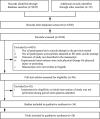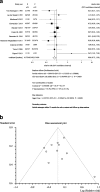Active contact and follow-up interventions to prevent repeat suicide attempts during high-risk periods among patients admitted to emergency departments for suicidal behavior: a systematic review and meta-analysis
- PMID: 30683075
- PMCID: PMC6347824
- DOI: 10.1186/s12888-019-2017-7
Active contact and follow-up interventions to prevent repeat suicide attempts during high-risk periods among patients admitted to emergency departments for suicidal behavior: a systematic review and meta-analysis
Abstract
Background: There is evidence that several intervention types, including psychotherapy, reduce repeat suicide attempts. However, these interventions are less applicable to the heterogeneous patients admitted to emergency departments (EDs). The risk of a repeat suicide attempt is especially high in the first 6 months after the initial attempt. Therefore, it is particularly important to develop effective ED interventions to prevent repeat suicide attempts during this 6-month period.
Methods: We systematically reviewed randomized controlled trials of ED-initiated interventions for suicidal patients admitted to EDs using the databases MEDLINE, PsychoINFO, CINAHL, and EMBASE up to January 2015 in accordance with an a priori published protocol (PROSPERO: CRD42013005463). Interventions were categorized into four types, including active contact and follow-up interventions (intensive care plus outreach, brief interventions and contact, letter/postcard, telephone, and composite of letter/postcard and telephone), and a meta-analysis was conducted to determine pooled relative risks (RRs) and 95% confidence intervals (CIs) of a repeat suicide attempt within 6 months.
Results: Of the 28 selected trials, 14 were active contact and follow-up interventions. Two of these trials (n = 984) reported results at 6 months (pooled RR = 0.48; 95% CI: 0.31 to 0.76). There were not enough trials of other interventions to perform meta-analysis. Some trials included in the meta-analysis were judged as showing risk of bias.
Conclusion: Active contact and follow-up interventions are recommended for suicidal patients admitted to an ED to prevent repeat suicide attempts during the highest-risk period of 6 months.
Systematic review registration: PROSPERO CRD42013005463 (27 August 2013).
Keywords: Emergency department; Meta-analysis; Self-harm; Suicide; Systematic review.
Conflict of interest statement
Ethics approval and consent to participate
Not applicable.
Consent for publication
Not applicable.
Competing interests
MI has received lecture fees from Pfizer Japan Inc.; Mochida Pharmaceutical Co., Ltd.; Shionogi & Co., Ltd.; Sumitomo Dainippon Pharma Co., Ltd.; Daiichi Sankyo Co., Ltd.; Meiji Seika Pharma Co., Ltd.; and Takeda Pharmaceutical Co., Ltd. outside the submitted work. He has received royalties from Nippon Hyoron Sha Co., Ltd.; Nanzando Co., Ltd.; Seiwa Shoten Co., Ltd.; Igaku-shoin Ltd.; and Technomics, Inc. outside the submitted work. He has received grant or research support from the Japanese Ministry of Health, Labour and Welfare and the Japanese Ministry of Education, Science, and Technology. Dr. Inagaki’s institution has received grant or research support from Eisai Co., Ltd.; Mochida Pharmaceutical Co., Ltd.; Astellas Pharma Inc.; Otsuka Pharmaceutical Co., Ltd.; GlaxoSmithKline K. K.; Shionogi & Co.; Sumitomo Dainippon Pharma Co., Ltd.; Jansen Pharmaceutical K. K.; Pfizer Japan Inc.; MSD K. K.; Yoshitomiyakuhin Corporation; Daiichi Sankyo Co., Ltd.; Meiji Seika Pharma Co., Ltd.; Tsumura & Co.; AbbVie; Ono Pharmaceutical Co., Ltd.; and Eli Lilly Japan K. K. YK has received royalties from Seiwa Shoten Co., Ltd. outside the submitted work. He has received grants from Seseragi-Foundation and an Intramural Research Grant for Neurological and Psychiatric Disorders of National Center of Neurology and Psychiatry outside the submitted work. MY has received grant or research support from received grants from the Japan Agency for Medical Research and Development during the study; grants from the Ministry of Health, Labour and Welfare, Japan; grants from the Ministry of Education, Culture, Sports, Science and Technology, Japan; grants from The Japan Science and Technology Agency; grants from the National Center of Neurology and Psychiatry; personal fees from Meiji Seika Pharma Co., Ltd.; personal fees from MSD K.K.; personal fees from Asahi Kasei Pharma Corporation; personal fees from Seishin Shobo; personal fees from Seiwa Shoten Co., Ltd.; personal fees from Igaku-shoin Ltd.; personal fees from Chogai Igakusha; and personal fees from Sentan Igakusha. All other authors declare that they have no competing interests.
Publisher’s Note
Springer Nature remains neutral with regard to jurisdictional claims in published maps and institutional affiliations.
Figures



References
-
- World Health Organization. Health statistics and information system, Disease burden and mortality estimates. https://www.who.int/healthinfo/global_burden_disease/estimates/en/index1.... Accessed 12 Jan 2019.
-
- World Health Organization. Preventing suicide—a global imperative. http://apps.who.int/iris/bitstream/10665/131056/1/9789241564779_eng.pdf?.... Accessed 21 Apr 2016.
-
- Arias SA, Miller I, Camargo CA, Jr, Sullivan AF, Goldstein AB, Allen MH, Manton AP, Boudreaux ED. Factors associated with suicide outcomes 12 months after screening positive for suicide risk in the emergency department. Psychiatr Serv. 2016;67(2):206–213. doi: 10.1176/appi.ps.201400513. - DOI - PMC - PubMed
Publication types
MeSH terms
LinkOut - more resources
Full Text Sources
Medical

